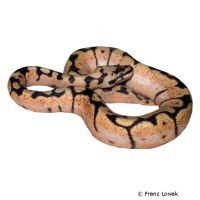Ball Python Bumlebee (Python regius)
| Ball Python Bumlebee Python regius | |
|---|---|
| Name | Ball Python Bumlebee |
| Name Lat. | Python regius |
| Family | Pythons |
| Family lat. | Pythonidae |
| Order | Scaled Reptiles |
| Order lat. | Squamata |
| Origin | Africa |
| Habitat | Savanna |
| Diet | Rodents |
| Humidity | 60-80 % |
| Behavior | Nocturnal, peaceful |
| Keeping | Individual, pair, group |
| Care Level | Moderate |
| Reproduction | Oviparous |
| Housing | Semi-humid terrarium |
| Life Span | 15-20 years |
| Protection | CITES Appendix II; EU Annex B |
| Metric Units | |
| Size | 130 cm |
| Temperature | 28-30 °C |
| Temperature Local | 35 °C |
| Housing Size | 150 x 80 x 100 cm |
| US Units | |
| Size | 51" |
| Temperature | 82-86 °F |
| Temperature Local | 95 °F |
| Housing Size | 60" x 30" x 40" |
Distribution and habitat
The crepuscular and nocturnal, predominantly ground-dwelling king pythons are widespread in Central and West Africa. They live in wet and dry savannas as well as in bush and cultivated land. Only farm and terrarium captive bred specimens enter the trade.
Maintenance
Minimum dimensions for the terrarium, according to the size and number of animals:
| 1-2 animals | 1KL x 0,5KL x 0,75KL (L x W x H) |
Body length (KL) is measured on the largest animal. For each additional animal the floor space should be increased by 20%. A terrarium of e.g. L 150 x W 80 x H 100 cm is recommended, which should be placed in a quiet and vibration-free place.
They need a terrarium structured with large roots, stable climbing branches, plants and stones (hiding places and visual protection) with a moisture-retaining substrate, e.g. of peat-earth mixture with foliage, a moist shelter (Sphagnum moss) as well as a large, easy-to-clean water basin (approx. 1/3 of the bottom surface) for bathing. A quarter of the substrate should always be kept slightly moist. Once a day, preferably in the evening, the inside of the terrarium should be finely sprayed with water (humidity), but a rain or mist system is better.
| Temp. day: 28-30 °C | Temp. night: 22-25 °C | Temp. local: up to 35 °C | Humidity: 60-80 |
Thermostatically controlled floor heating is recommended. Lighting duration must be 12-14 hrs. depending on the season. Daylight fluorescent tubes are ideal.
Diet
According to their size, they feed on mice, rats, guinea pigs and other rodents, as well as chicks and small pigeons. After acclimation, they often succeed in switching to dead food animals. Juveniles should be offered food every 8-10 days and adults every 14-20 days, with occasional periods of fasting (e.g., skipping a feeding). If the snake is disturbed after feeding, this may result in vomiting of the prey. Generally, it is better to offer several small feeders, rather than one large one. If it does not eat for a long period of time, both the timing and the food should be varied. It is important to fortify the food animals with vitamins and minerals. Since the snake could be injured by live rodents, it should not be left unattended with them.
Reproduction and breeding
Probing by the veterinarian is the only reliable method of sex determination. The female lays 4-6 eggs, in a warm, moist trough and incubates the clutch for 55-60 days, beica. 30 °C. By muscle contraction the female can keep the temperature constant. The 36-45 cm young can be fed with nest young mice after a few days
Species protection
They are exempt from the obligation to notify (Federal Species Protection Ordinance (BArtSchV) Appendix 5 to § 7 para. 2). Your pet store will be happy to provide you with further information.
Species protection: WA Appendix II; EU Appendix B. The purchase receipt is the required proof of origin for the animal. Please keep it safe!
Important
They are bred in numerous color morphs and new designer morphs are constantly being added
If they feel disturbed, they usually curl up into a "ball". They are relatively easy to handle and peaceful within the species. If the air temperature in the terrarium is lower than the temperature in the water tank, there is a risk of respiratory infection. For the resting period, shorten the lighting time by 3-4 hours and lower the temperature by 4-6 °C
When handling always have snake hooks, protective gloves and cold water ready.
The terrarium must have good ventilation without drafts and meet the species specific needs. Measuring devices such as thermometers, hygrometers, etc. are necessary. The lighting has to correspond to the species-specific day-night rhythm and has to be placed in such a way that the animals cannot injure themselves. The terrarium should be locked in such a way that neither unauthorized persons can open it nor the animals can escape. Contamination must be removed regularly
Further literature can be found in your pet store.
References
Text: petdata; Image: petdata
Source: BMELV (1997): Tierschutzgutachten - Mindestanforderung an die Haltung von Reptilien; ENGELMANN (2006): Zootierhaltung - Tiere in menschlicher Obhut: Reptilien und Amphibien, Harri Deutsch Verlag
- Gemäß § 21 Abs. 5 Tierschutzgesetz idgF
